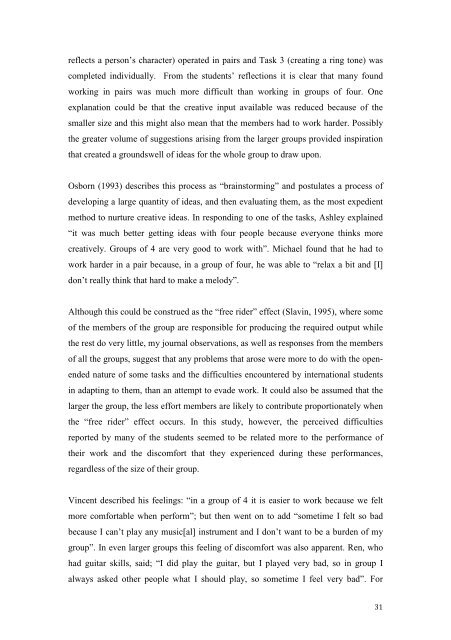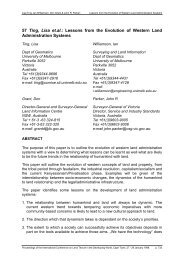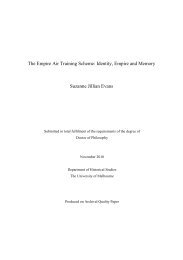approaches to creativity in the music classroom - University of ...
approaches to creativity in the music classroom - University of ...
approaches to creativity in the music classroom - University of ...
You also want an ePaper? Increase the reach of your titles
YUMPU automatically turns print PDFs into web optimized ePapers that Google loves.
eflects a person’s character) operated <strong>in</strong> pairs and Task 3 (creat<strong>in</strong>g a r<strong>in</strong>g <strong>to</strong>ne) wascompleted <strong>in</strong>dividually. From <strong>the</strong> students’ reflections it is clear that many foundwork<strong>in</strong>g <strong>in</strong> pairs was much more difficult than work<strong>in</strong>g <strong>in</strong> groups <strong>of</strong> four. Oneexplanation could be that <strong>the</strong> creative <strong>in</strong>put available was reduced because <strong>of</strong> <strong>the</strong>smaller size and this might also mean that <strong>the</strong> members had <strong>to</strong> work harder. Possibly<strong>the</strong> greater volume <strong>of</strong> suggestions aris<strong>in</strong>g from <strong>the</strong> larger groups provided <strong>in</strong>spirationthat created a groundswell <strong>of</strong> ideas for <strong>the</strong> whole group <strong>to</strong> draw upon.Osborn (1993) describes this process as “bra<strong>in</strong>s<strong>to</strong>rm<strong>in</strong>g” and postulates a process <strong>of</strong>develop<strong>in</strong>g a large quantity <strong>of</strong> ideas, and <strong>the</strong>n evaluat<strong>in</strong>g <strong>the</strong>m, as <strong>the</strong> most expedientmethod <strong>to</strong> nurture creative ideas. In respond<strong>in</strong>g <strong>to</strong> one <strong>of</strong> <strong>the</strong> tasks, Ashley expla<strong>in</strong>ed“it was much better gett<strong>in</strong>g ideas with four people because everyone th<strong>in</strong>ks morecreatively. Groups <strong>of</strong> 4 are very good <strong>to</strong> work with”. Michael found that he had <strong>to</strong>work harder <strong>in</strong> a pair because, <strong>in</strong> a group <strong>of</strong> four, he was able <strong>to</strong> “relax a bit and [I]don’t really th<strong>in</strong>k that hard <strong>to</strong> make a melody”.Although this could be construed as <strong>the</strong> “free rider” effect (Slav<strong>in</strong>, 1995), where some<strong>of</strong> <strong>the</strong> members <strong>of</strong> <strong>the</strong> group are responsible for produc<strong>in</strong>g <strong>the</strong> required output while<strong>the</strong> rest do very little, my journal observations, as well as responses from <strong>the</strong> members<strong>of</strong> all <strong>the</strong> groups, suggest that any problems that arose were more <strong>to</strong> do with <strong>the</strong> openendednature <strong>of</strong> some tasks and <strong>the</strong> difficulties encountered by <strong>in</strong>ternational students<strong>in</strong> adapt<strong>in</strong>g <strong>to</strong> <strong>the</strong>m, than an attempt <strong>to</strong> evade work. It could also be assumed that <strong>the</strong>larger <strong>the</strong> group, <strong>the</strong> less effort members are likely <strong>to</strong> contribute proportionately when<strong>the</strong> “free rider” effect occurs. In this study, however, <strong>the</strong> perceived difficultiesreported by many <strong>of</strong> <strong>the</strong> students seemed <strong>to</strong> be related more <strong>to</strong> <strong>the</strong> performance <strong>of</strong><strong>the</strong>ir work and <strong>the</strong> discomfort that <strong>the</strong>y experienced dur<strong>in</strong>g <strong>the</strong>se performances,regardless <strong>of</strong> <strong>the</strong> size <strong>of</strong> <strong>the</strong>ir group.V<strong>in</strong>cent described his feel<strong>in</strong>gs: “<strong>in</strong> a group <strong>of</strong> 4 it is easier <strong>to</strong> work because we feltmore comfortable when perform”; but <strong>the</strong>n went on <strong>to</strong> add “sometime I felt so badbecause I can’t play any <strong>music</strong>[al] <strong>in</strong>strument and I don’t want <strong>to</strong> be a burden <strong>of</strong> mygroup”. In even larger groups this feel<strong>in</strong>g <strong>of</strong> discomfort was also apparent. Ren, whohad guitar skills, said; “I did play <strong>the</strong> guitar, but I played very bad, so <strong>in</strong> group Ialways asked o<strong>the</strong>r people what I should play, so sometime I feel very bad”. For31
















